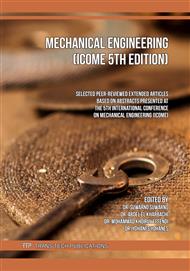[1]
E. A. Ofudje, A. I. Adeogun, M. A. Idowu, and S. O. Kareem, Synthesis and characterization of Zn-Doped Hydroxyapatite: Scaffold Application, Antibacterial and Bioactivity Studies, Heliyon, vol. 5, no. 5, (2019) 1–12.
DOI: 10.1016/j.heliyon.2019.e01716
Google Scholar
[2]
M. A. Louyeh, Silver, Magnesium and Zinc Substituted Hydroxyapatite for Orthopaedic Applications. May (2016) 34.
Google Scholar
[3]
D. T. Agustiningtyas, G. Umindya, N. Tajalla, and N. Sasria, Pembuatan Hidroksiapatit Doping Zn Dengan Menggunakan Bantuan Radiasi Gelombang Mikro, Balikpapan, (2020).
Google Scholar
[4]
M. Safari Gezaz, S. Mohammadi Aref, and M. Khatamian, Investigation of Structural Properties of Hydroxyapatite/Zinc Oxide Nanocomposites; an Alternative Candidate for Replacement in Recovery of Bones in Load-Tolerating Areas, Materials Chemistry and Physics 226 (2019) 169–176.
DOI: 10.1016/j.matchemphys.2019.01.005
Google Scholar
[5]
M. Akram, A. Z. Alshemary, Y. F. Goh, W. A. Wan Ibrahim, H. O. Lintang, and R. Hussain, Continuous Microwave Flow Synthesis of Mesoporous Hydroxyapatite, Materials Science and Engineering C 56 (2015) 356–362.
DOI: 10.1016/j.msec.2015.06.040
Google Scholar
[6]
N. Thadavirul, P. Pavasant, and P. Supaphol, Development of Polycaprolactone Porous Scaffolds by Combining Solvent Casting, Particulate Leaching, and Polymer Leaching Techniques for Bone Tissue Engineering, J Biomed Mater Res Part A (2014):102A:3379–3392.
DOI: 10.1002/jbm.a.35010
Google Scholar
[7]
M. Rajkumar, N. Meenakshisundaram, and V. Rajendran, Development of Nanocomposites Based on Hydroxyapatite/Sodium Alginate: Synthesis and Characterisation, Mater. Charact., vol. 62, no. 5, (2011) 469–479.
DOI: 10.1016/j.matchar.2011.02.008
Google Scholar
[8]
A. A. Maharani, A. Husni, and N. Ekantari, Karakteristik Natrium Alginat Rumput Laut Cokelat Sargassum Fluitans dengan Metode Ekstraksi yang Berbeda, Jphpi, vol. 20, no. 3, (2017) 478–487.
Google Scholar
[9]
S. Alborzi, Encapsulation of Folic Acid in Sodium Alginate-Pectin-Poly (Ethylene Oxide) Electrospun Fibers to Increase Its Stability, Canada, (2012).
DOI: 10.3109/02652048.2012.696153
Google Scholar
[10]
F. A. Siswoyo, Kumalasari, Sari Wulan, Fabrikasi Perancah Berpori Hidroksiapatit dari Tulang Ikan Tenggiri dengan Alginat Sebagai Binder Alami: Sebuah Kajian Naratif, J. Pendidik. Fis. dan Sains, vol. 3, no. 2 (2020) 35–42.
DOI: 10.52188/jpfs.v3i2.82
Google Scholar
[11]
T. W. Bintarti, Sintesis dan Karakterisasi Bone Graft Berbasis Hidroksiapatit dan Alginat, J. Chem. Inf. Model., (2012).
Google Scholar
[12]
H. H. Indrani, Decky J., Emil Budiyanto, Preparation and Characterization of Porous Hydroxyapatite and Alginate Composite Scaffolds for Bone Tissue Engineering, Int. J. Appl. Pharm., vol. 9, no. 2 (2017) 98–102.
DOI: 10.22159/ijap.2017.v9s2.24
Google Scholar
[13]
Purnawan Gunawan, Sunarmasto, and Andi Dwi Yunanto, Studi Kuat Tekan, Kuat Tarik Belah, dan Modulus Elastisitas Beton Ringan Teknologi Foam dengan Bahan Tambah Serat Polyester, Matriks Tek. Sipil, vol. 3 (2014) 619–627.
DOI: 10.20961/mateksi.v9i3.54494
Google Scholar
[14]
N. Nuha, N. Nurlely, and Y. W. Sari, Influence of Microwave Irradiation Time and Cross-Linker Additions on Synthesis of Hydroxyapatite-Alginate (HA-Alginate) Composite, J. Phys. Conf. Ser., vol. 1505, no. 1, (2020).
DOI: 10.1088/1742-6596/1505/1/012058
Google Scholar
[15]
F. Afriani, Perancah Berpori Hidroksiapatit dan β-Tricalcium Phosphate dari Limbah Cangkang Telur Ayam dengan Porogen Alginat Fitri Afriani, (2015).
DOI: 10.52188/jpfs.v3i2.82
Google Scholar
[16]
J. N. Setiadiputri, Sintesis dan Karakterisasi Biokomposit Hidroksiapatit-Alginat-Zinc Sebagai Bone Graft untuk Penanganan Bone Defect, J. Chem. Inf. Model., vol. 53, no. 9 (2018) 1–102.
Google Scholar
[17]
M. R. Aufan, A. H. Daulay, D. Indriani, and A. Nuruddin, Sintesis Scaffold Alginat-Kitosan-Karbonat Apatit Sebagai Bone Graft Menggunakan Metode, J. Biofisika, vol. 8, no. 1, (2012) 16–24.
Google Scholar
[18]
L. El Milla, D. J. Indrani, and B. Irawan, Sintesis dan Uji Porositas Scaffold Hidroksiapatit/Alginat, ODONTO Dent. J., vol. 5, no. 1, (2018) 49.
DOI: 10.30659/odj.5.1.49-53
Google Scholar
[19]
N. N. Pradita, Pengaruh Penambahan Kitosan Terhadap Biokompatibilitas Komposit Kitosan–Hidroksiapatit Terdoping Seng Sebagai Kandidat Material Pengganti Tulang (Bone Substitute), (2016).
Google Scholar
[20]
V. P. Orlovskii, V. S. Komlev, and S. M. Barinov, Hydroxyapatite and Hydroxyapatite-Based Ceramics, Inorg. Mater., vol. 38, no. 10, (2002) 973–984.
DOI: 10.1023/a:1020585800572
Google Scholar



